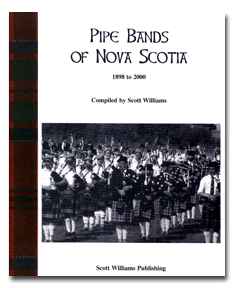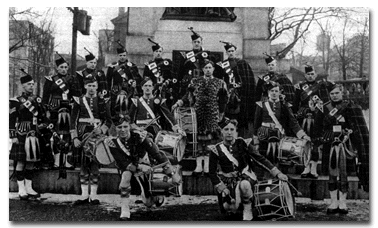|

|

|
Pipe Bands of Nova Scotia
1898-2000
Pipe bands have existed in Nova Scotia
for more than one hundred years. From the MacIntyre
Caledonia Pipe Band of 1898, to the military pipe
bands of two world wars, to the girls' bands which
dominated the scene in the 1950s and 1960s, and on
to the bands which attained national and
international recognition in the last quarter of
the 20th Century, more than 150 pipe bands have
marched down the streets of Nova Scotian cities,
towns, and villages and have performed at hundreds
of Highland games, parish picnics, ship launchings,
Remembrance Day, Homecoming, and Natal Day parades,
sports events, and summer festivals of every
description. In fact, it's hard to imagine anything
significant happening in Nova Scotia without the
music of the pipes! Love them or hate them, pipe
bands have been a significant part of Nova Scotia's
diverse cultural 'quilt' for more than a century,
and will continue to be well into the new
millennium.
|
Dedication
It gives me great pleasure to dedicate this work to my
first piping instructors - the late Alexander (Sandy) Ross
Boyd, the late Pipe Major William "Bill" Magennis, and James
Barry Ewen. It was my very good fortune to have had their
guidance during my formative years.
From Sandy I learned correct finger technique and the
ability to read and write music. From Bill I received the
ability to teach others and to love my students as if they
were my children, for all Bill's students were part of his
family. From Barry I received an appreciation for accuracy,
unison playing, and a high quality of sound - that
"Antigonish Sound", as our band manager, the late Charlie
MacDougall, often called it.
It is their attitudes, knowledge, and skills that I have
been attempting to pass on to my own students for more than
three decades.
Foreword
The MacIntyre family of Glace Bay started Nova Scotia's
first civilian pipe band by 1898. Robert Thompson formed one
in Halifax by 1904, and Andrew Holmes soon followed with
another in Pictou County by 1906. By the outbreak of World
War I, there were enough musicians in Nova Scotia with pipe
band experience to fill the province's military bands for
service at home and overseas. George Dey and James Cant of
Halifax, Fraser Holmes and Wallace Roy of Pictou County,
John A. "Black Jack" MacDonald of Soldier's Cove, Ross Stone
of Truro, Rod Nicholson of Sydney, and Herman Beaton of
Antigonish County trained bands during and after World War
II. Fraser Holmes started the first all girls' pipe band in
Nova Scotia in 1948 and soon others were springing up all
over the province, a trend that continued to the late 1960s.
Jack MacIsaac, Harold MacDonnell, Barry Ewen, and Bill
Magennis helped elevate the standard of pipe bands in the
60s and 70s, and Doug Boyd, Madelyn (Russell) Evans, Wayne
Moug, John Walsh, Barb Stewart, Mark Stewart, Roderick
MacLean, and a host of others continue to make their
contributions today.
I thoroughly enjoyed working on this book, "Pipe Bands of
Nova Scotia 1898 to 2000", and its companion, "Pipers of
Nova Scotia Biographical Sketches 1773 to 2000", which was
published in June, 2000. It is my hope that both will be
considered significant contributions to the historical
record of Nova Scotia's Scottish music and culture
Scott Williams
January, 2001
Sample from "Pipe Bands of Nova Scotia, 1898-2000"
|

|
Pictou Highlanders Pipe Band at
Halifax, c 1943
|
|
Pictou Highlanders Pipe Band, of New Glasgow.
The Pictou Highlanders can trace their history back
to 1871 when the 78th Colchester, Hants &
Pictou Highlanders were organized. In 1910, there
was strong agitation to outfit the Battalion in
kilts. The other counties disagreed, however, so
the unit was re-organized and the Pictou County
branch was re-named the 78th Pictou Highlanders,
also known as the Pictou Regiment. In 1911, the
Pictou Highlanders provided the Guard of Honour when
the Duke of Connaught, then Governor General of
Canada, visited Pictou. In 1914, when World War I
broke out, members of this regiment were sent to
Valcartier, Quebec, where they formed the nucleus
of the 17th (Nova Scotia Seaforth Highlanders of
Canada) CEF Battalion. When the 40th Battalion was
raised, the Pictou Highlanders supplied members to
that as well.
In 1920, the regiment was re-organized again and
was named the Pictou Highlanders. A camp was held
in Pictou to coincide with the anniversary
celebrations of the arrival of the Hector, and
similar camps were held annually until 1939.
In the 1930s, some of the members of the Pictou
Highlanders Pipe Band were pipers Wallace Roy and
Mike MacNeil, snare drummer Danny MacLellan, and
bass drummer Davie Matheson. An unidentified
clipping dated November 28th, 1936 contains a photo
of the band with the following members: Pipe Major
Wallace Roy, pipers James Burns, Clarence MacLeod,
Walter Roy, Corporal Alex Ingraham, Sergeant Norman
MacLeod, Roy Sexton and Alex Hasey, drummers Pete
MacLellan, Corporal Marshall, Sergeant Matheson,
Dan MacLellan and Sergeant Lee Carroll. In the
Article, the band was referred to as the Regimental
Pipe Band of the Pictou Highlanders, Headquartered
at Stellarton.
In September 1939, Canada declared war on
Germany and the regiment was mobilized and drafted
other units including the West Nova Scotia Regiment
and the North Nova Scotia Highlanders. The
Pictou's role was a defensive one in Canada and
they were never engaged in battle. At first, they
were under canvas at Sand Point, near Mulgrave, on
the Strait of Canso. The band continued to
perform, but without Wallace Roy as their Pipe
Major. In 1940 and 1941, the band participated in
the Antigonish Highland Games, placing second in
1941. Their first move was to Newfoundland for
coastal defense duties from March to August of
1943. In September of 1943, a company was
dispatched to Nassau, the Bahamas, where it
performed garrison duties until March of 1946. A
second company was sent for service in Bermuda from
November 12th, 1942 to April 1st, 1946.
In the summer of 1944, the pipe band
participated in a War Bond Drive. There were
troops on parade and displays of military
equipment.. The band performed a Ceremonial
Retreat at Carmichael Park, beside the East River
in New Glasgow. Boy Piper Don Roy joined the local
Reserve Army Pipe Band in April 1945, and in his
very first outing, marched in the front row next to
Pipe Major Fraser Holmes. Pipers Jack Fleming of
Stellarton and Harold Hayden of Pictou were in the
band, and one of the drummers from that time was
"Satch" Sarson, from Pictou.
On VE Day (Victory in Europe), the band was
loaded onto the back of an army truck and toured
Stellarton, New Glasgow, Westville and Trenton with
the band playing through the Main Streets of these
towns. The band went to summer camp at Beach
Grove, on the outskirts of Charlottetown, and while
ther, the band performed a live half-hour radio
broadcast from the Charlottetown Armories. VJ Day
(Victory in Japan) followed soon after and when the
news arrived, the band was performing at the
Greenhill look-off. Everyone began celebrating
including young Don Roy, and his father, Wallace.
The 2nd (Reserve) Battalion served in Nova
Scotia. It recruited, trained, and supplied
re-enforcements to the 1st Battalion. This 2nd Battalion was reorganized in 1946 and designated
the Pictou Highlanders (Motor) Battalion. They
continued to perform at the Antigonish Highland
Games to 1950 and again in 1954. In 1954, the 2nd
Battalion became part of the Nova Scotia
Highlanders and traded in its MacKenzie tartan for
the MacDonald. At this time, the pipe Major of the
band was Jack Fleming.
|
|